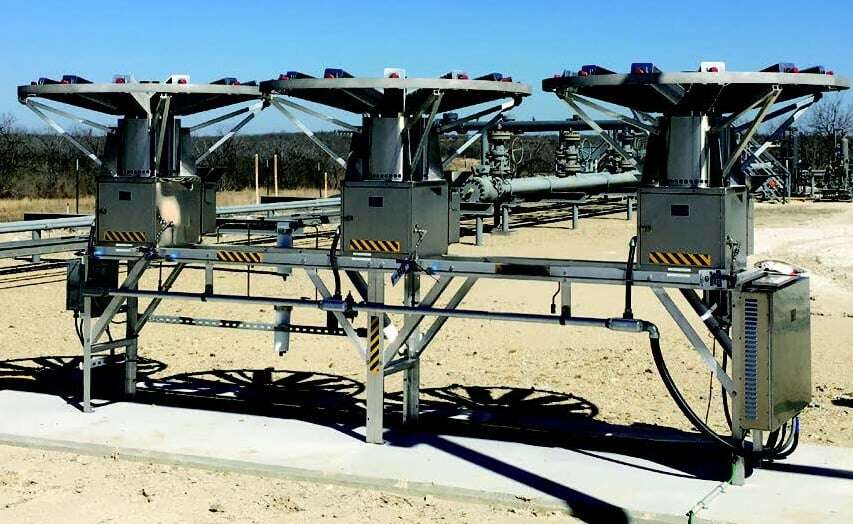Cathodic Protection for Today's Pipelines

Corrosion is a major issue that can lead to premature failure in pipelines, resulting in significant economic losses and safety risks. Installing a cathodic protection system is an effective solution. Industry standards, such as those outlined by the National Association of Corrosion Engineers, now mandate the use of either protective coatings or cathodic protection for buried steel pipelines and other requirements exist for the monitoring of corrosion risks. Corrosion rates vary from site to site depending on variables such as temperature, moisture and soil composition.
What is Cathodic Protection?
Cathodic Protection (CP) is a well-established technique used to protect the exposed external surfaces of underground structures from corrosion. It involves connecting the metal to be protected to a more easily corroded sacrificial metal, which acts as the anode. For larger structures, such as pipelines, which may cover extreme distances, passive galvanic cathodic protection may not provide adequate security. In these cases, an external DC power source is used to provide sufficient current to overcome the resistance by applying a negative voltage to the cathode and a positive voltage to the anode, which is known as Impressed Current CP.
Options for Cathodic Protection Power
There are several popular options to provide power for cathodic protection. The first is utility power. If available, this can be a straightforward solution. However, a rectifier needs to be installed to convert the AC power to DC. Connecting to the grid may also require additional infrastructure to reach the location or step down to the required power level, such as power lines and transformers, which can increase project costs and complexity. Furthermore, the ongoing monthly connection costs for grid power may be high relative to the actual power consumed.
Another solution, depending on the power requirements, is a solar system with battery storage. Solar power offers an environmentally friendly off-grid solution. However, the upfront cost of installing a solar and battery system can be significant, especially for large-scale applications or in poor solar insolation regions. The effectiveness of solar depends on the amount of sunlight available, which varies based on location and weather conditions. Additionally, solar and battery systems have higher maintenance requirements than other solutions, including regular cleaning and inspections or battery failure in extreme heat or cold. Dust or debris on solar panels can significantly affect the overall output of a solar system. As well, solar panels and battery systems are attractive theft targets, which may require additional security measures.
TEGs (thermoelectric generators) are a particularly attractive option for pipelines, which are nearly always in remote areas, cover vast distances, and may lack access to main utility line power. They offer standalone power, eliminating reliance on the grid or solar. The output of a TEG is DC in nature, so a rectifier is not required, leading to reduced losses and increased reliability. TEGs require minimal maintenance, reducing operating costs and downtime and they can easily be adapted to various site conditions and power requirements. A cathodic protection interface panel is typically installed with a TEG to adjust its output voltage.
Current Challenges
As pipelines age and soil conditions fluctuate with variations in water content, they may require higher voltages to maintain adequate cathodic protection. Older systems may require upgrades to accommodate the increased current requirements of aging pipelines.
Sometimes the current and voltage may also need to be temporarily adjusted. While manual adjustments can be made at the cathodic protection interface panel, this can be labor-intensive. An auto-cathodic protection panel offers a more efficient solution by automatically adjusting the panel output to meet the changing requirements.
Factors to Consider When Assessing Cathodic Protection Options
There are many factors to consider when selecting a power source for cathodic protection. It is important to weigh the pros and cons of each project’s specific needs and circumstances. Here are some things to consider:
- Longevity - How long will the system last? A solar plus battery system may last 10-15 years, but TEGs have demonstrated impressive longevity. Global Power Technologies has several case studies showcasing models exceeding 30 years of service.
- Ability to withstand conditions and reliability - TEGs are known for their exceptional reliability and ability to operate continuously in various environmental conditions, unaffected by power outages or grid fluctuations.
- Cost - While TEGs may have similar or slightly higher initial costs, their long lifespan and minimal maintenance requirements can offset this over time.
- Space requirements and site considerations - TEGs are often smaller and more flexible in terms of placement, making them suitable for various site conditions, especially where line power is unavailable.
- Maintenance - TEGs require minimal maintenance, reducing operational costs and downtime.
- Additional factors - Environmental impact, scalability, and regulatory compliance should also be considered. TEGs are considered to be environmentally friendly due to their low carbon footprint. They are incredibly versatile and can be scaled to meet varying power requirements.
Which TEGs are commonly used for Cathodic Protection?
Global Power Technologies offers a range of cost-effective TEG models suitable to power cathodic protection systems. While a single TEG can cover most applications, multiple TEGs can be used for higher power requirements. Global Power Technologies also offers a comprehensive cathodic protection panel package for unattended and continuous power supply. The GPT sales team can assist in selecting the ideal solution for any project.
Global Power Technologies TEG Models:
While each power source offers its own benefits, TEGs are a strong contender for cathodic protection system power. They reduce reliance on the grid or stand-alone solar, are well known for their longevity and minimal maintenance requirements, and are environmentally friendly. They can even utilize natural gas from the very pipelines they are protecting. TEGs offer unbeatable flexibility, and can easily be adapted to various site conditions and requirements. Selecting a TEG to power cathodic protection systems ensures long-term protection while minimizing costs and environmental impact.